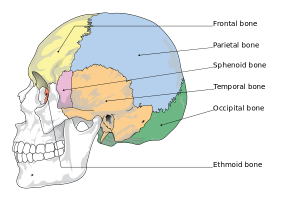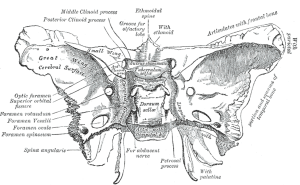Sphenoid Bone: Difference between revisions
No edit summary |
No edit summary |
||
| Line 1: | Line 1: | ||
[[File:600px-Cranial bones en.svg.png|thumb|Cranial Bones. Only the end of the wing of the sphenoid bone is visible]] | [[File:600px-Cranial bones en.svg.png|thumb|Cranial Bones. Only the end of the wing of the sphenoid bone is visible]] | ||
The [[Sphenoid Bone]] is an unpaired bone of the neurocranium. It is situated in the middle of the skull towards the front, in front of the temporal bone and the basilar part of the occipital bone. The sphenoid bone is one of the seven bones that articulate to form the orbit. Its shape somewhat resembles that of a butterfly or bat with its wings extended.The sphenoid bone is the only bone that connects to all the other bones of the cranium and its movement is responsible for "milking" the | The [[Sphenoid Bone]] is an unpaired bone of the neurocranium. It is situated in the middle of the skull towards the front, in front of the temporal bone and the basilar part of the occipital bone. The sphenoid bone is one of the seven bones that articulate to form the orbit. Its shape somewhat resembles that of a butterfly or bat with its wings extended.The sphenoid bone is the only bone that connects to all the other bones of the cranium and its movement is responsible for "milking" the [[Pituitary Gland]] to secrete its hormones. | ||
[[File:600px-Gray145.png|thumb|Sphenoid bone, upper surface]] | [[File:600px-Gray145.png|thumb|Sphenoid bone, upper surface]] | ||
| Line 12: | Line 12: | ||
[[File:Orbital bones.png|thumb|Seven bones articulate to form the orbit. The sphenoid bone is shown as pink (directly in the middle of the orbital cavity)]] | [[File:Orbital bones.png|thumb|Seven bones articulate to form the orbit. The sphenoid bone is shown as pink (directly in the middle of the orbital cavity)]] | ||
==Importance of the Sphenoid== | |||
There are 22 bones that make up the skull, and the sphenoid is one of the 8 bones of the neurocranium. It is situated at the base of the skull, acting as the keystone. A keystone in architecture is the piece at the apex of an arch; it locks all the other pieces together and bears the weight. And just like a keystone holds everything together in an archway, so does the sphenoid in the skull. | |||
The sphenoid articulates with 12 bones: | |||
* frontal | |||
* occipital | |||
* parietals | |||
* temporals | |||
* zygomatics | |||
* ethmoid | |||
* vomer | |||
* palatines | |||
| Line 28: | Line 43: | ||
[[Pineal Gland]] | [[Pineal Gland]] | ||
[[Krystal Palace]] | |||
[[category:Ascension]][[category:Newsletter]] | [[category:Ascension]][[category:Newsletter]] | ||
Revision as of 21:12, 6 February 2017
The Sphenoid Bone is an unpaired bone of the neurocranium. It is situated in the middle of the skull towards the front, in front of the temporal bone and the basilar part of the occipital bone. The sphenoid bone is one of the seven bones that articulate to form the orbit. Its shape somewhat resembles that of a butterfly or bat with its wings extended.The sphenoid bone is the only bone that connects to all the other bones of the cranium and its movement is responsible for "milking" the Pituitary Gland to secrete its hormones.
It is divided into the following parts:
- a median portion, known as the body of sphenoid bone, containing the sella turcica, which houses the Pituitary Gland as well as the paired paranasal sinuses, the sphenoidal sinuses
- two greater wings on the lateral side of the body and two lesser wings from the anterior side.
- Pterygoid processes of the sphenoides, directed downwards from the junction of the body and the greater wings.
- Two sphenoidal conchae are situated at the anterior and posterior part of the body.[1]
Importance of the Sphenoid
There are 22 bones that make up the skull, and the sphenoid is one of the 8 bones of the neurocranium. It is situated at the base of the skull, acting as the keystone. A keystone in architecture is the piece at the apex of an arch; it locks all the other pieces together and bears the weight. And just like a keystone holds everything together in an archway, so does the sphenoid in the skull.
The sphenoid articulates with 12 bones:
- frontal
- occipital
- parietals
- temporals
- zygomatics
- ethmoid
- vomer
- palatines
References




